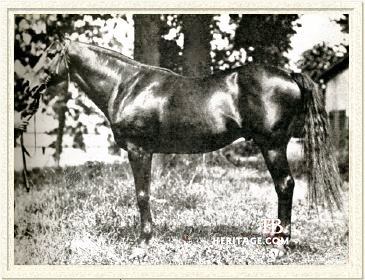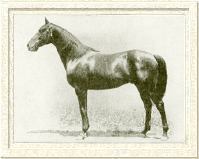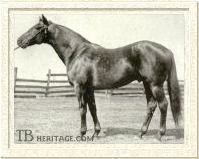|
|
Ben Brush

|
|
 |
|
|
Ben Brush was bred by Catesby Woodford and Ezekiel F. Clay and foaled
at their Runnymede Stud near Paris, Kentucky. The actual engineer
of the Bramble-Roseville mating, however, was Eugene Leigh, owner
of Bramble, who sold Roseville in foal to Bramble to the partners.
When the foal was offered as
a yearling at the annual Runnymede sale, Leigh was a partner with
trainer Ed Brown in buying the colt for $1,200. The colt was then
named for the track superintendent at the old Sheepshead Bay racetrack
on Long Island. Running in the name of his trainer, the two-year-old
Ben Brush dominated the 1895 racing year. Undefeated in his first
five starts in the Midwest, he lost his next three races after shipping
to New York, but regained his winning form in the Holly Handicap.
This victory prompted his purchase
(reportedly around $15,000) by Michael F. Dwyer, one of the famous
Dwyer Brothers who had raced in partnership until 1890, their runners
including Ben Brush's sire, Bramble. Ben Brush rounded out the season
with wins in the Prospect Handicap, Nursery, Albany, and Champagne
Stakes, with 13 wins in 16 starts that year. The following year, he
started eight times, winning half, including his season debut in the
Kentucky Derby, as well as the Buckeye Stakes, Latonia Derby, and
a dead-heat in the Shulte Stakes with Lady Inez. He was again considered
the best of his age in training. As a four-year-old in 1897, Ben Brush
matured into an even better runner, winning seven of 16 starts, including
the Suburban, Omnium, Brighton Handicap, Citizen's Handicap, and the
First and Second Special Stakes.
Thus champion every year he raced,
Ben Brush ended his race career with totals of 40 starts, 24 wins
and $65,208 in earnings. As the Dwyers had no interest in breeding,
Ben Brush was sold again, this time to James R. Keene, owner of Castleton
Stud outside of Lexington, Kentucky, who needed a replacement for
his great runner Domino, who had died in 1897 after siring only two
crops. At Castleton, Ben Brush embarked on another remarkable career,
this time as a stallion.
Ben Brush in the Stud
His first two crops (1899, 1900)
produced nothing of note, but the small 1901 crop included champion
juvenile and Belmont Stakes winner Delhi (out of Veva by *Mortemer)
and the top handicapper Broomstick (out of *Elf by Galliard), taking
him second on the Leading Sires' List in 1904. |

Champion juvenile Delhi

Champion Sweep | |
Subsequent crops included
champions Sweep (at two and three), Pebbles (at two), and the good
colts Von Tromp, Vandergrift, and Theo. Cook.
When
Sweep was the best two-year-old in training in 1909, Ben Brush led
the American Sires' List.
Keene died in 1913 and the 20-year-old
Ben Brush was sold privately to Senator Johnson N. Camden for $10,000.
Moved to Camden's Hartland Stud (which passed into the hands of the
Abercrombie family as Pin Oak Stud, and is now owned by the University
of Kentucky), near Versailles, Kentucky, he died on June 8, 1918 at
the age of 25. His grave at Hartland was marked with a simple stone
tablet that notes his date of death incorrectly as "1917."
Physically, Ben Brush resembled
his sire, Bramble to some degree, but really established his own physical
type that marked individuals from this bloodline for several generations.
Small, short-legged and long-bodied, the Ben Brushes were not noted
for their refinement, but were famous for their precociousness, speed,
and durability, a rare combination that made them extremely popular
and successful. |
For the first half of the 20th
Century, Ben Brush's male line was one of the most important male
lines in America, along with that of Domino and Fair Play. His sons
Sweep and Broomstick both succeeded him in later years as American
Leading Sires, as did Sweep's son, The Porter.
--Anne Peters |
|
|
|

